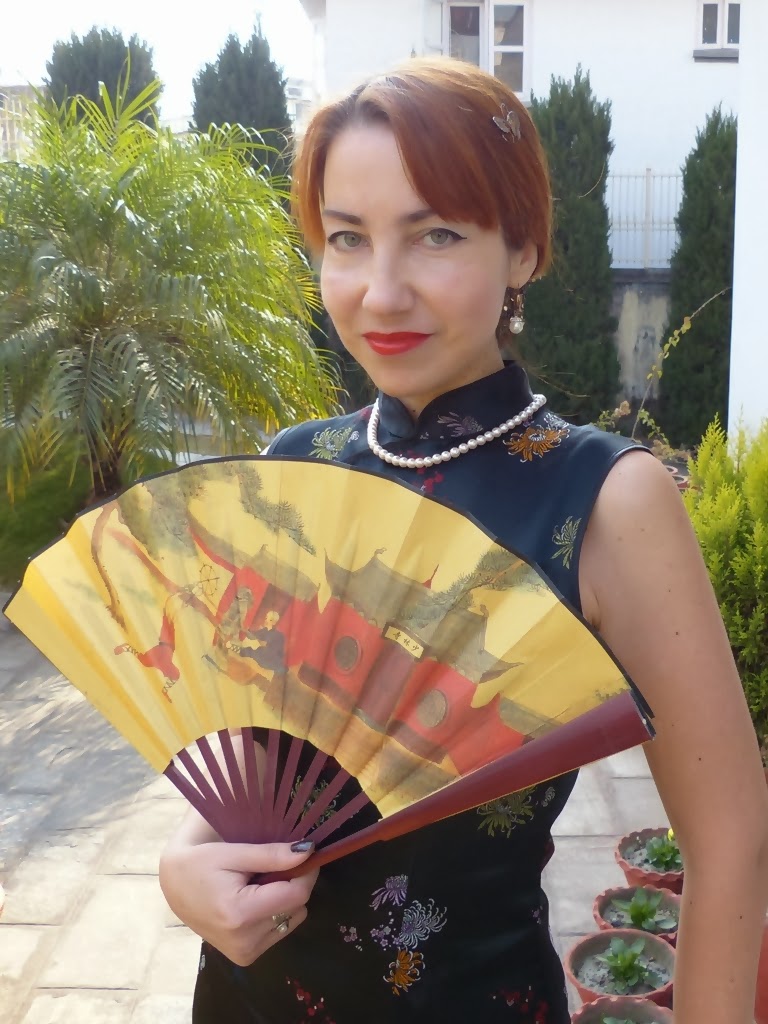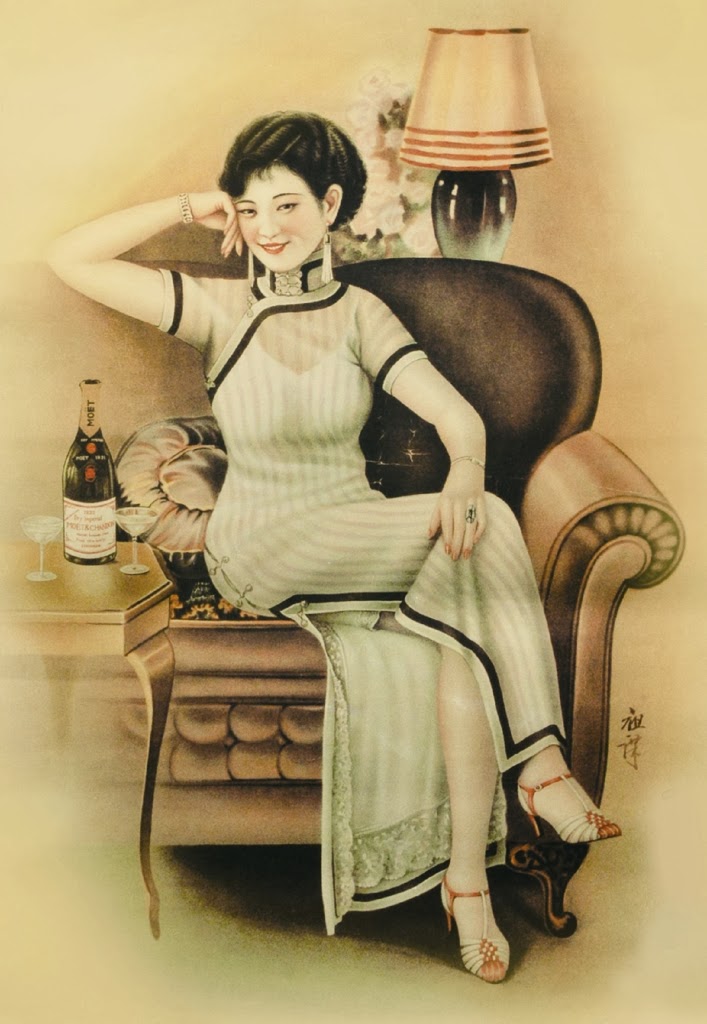Today is the Chinese New Year. And I thought it was a good time to show off my cheongsam/qipao and to tell you about this beautiful Chinese dress. Like Kungfu, Beijing opera, and acupuncture, the qipao is an instantly recognizable symbol of Chinese culture.
The Mandarin word "qipao" means "banner robe" and it was used to describe the long dress worn by women belonging to the Eight Banners (clans) of Manchu. It was a long A-shaped, loosely fitted and squarely cut silk brocade robe adorned with different embroidered motifs that reflected the status, position or title of the wearer.
Singers in qipao with trousers underneath, 1901 source
Qipao, ca. 1875-1908. It is loose and straight, embroidered with peonies and butterflies and adorned with elaborate and delicate trimmings. Hong Kong Museum of History
Because the robe had slits at the sides, trousers were always worn underneath to cover the legs. With the fall of the Quing dynasty in 1912 many believed that Manchu clothes should be discarded too. And though not completely abandoned, qipao underwent some changes. It was designed to be worn on its own, without trousers. The 1920s version of qipao had an upright collar, wide elbow-length sleeves, a fairly loose-fitting cut and no slits.
Hatamen Cigarettes advertising poster, 1920s source
1930s advertising poster source
In 1930s the slits came back however. They were long side slits but no trousers were worn underneath this time. The qipao's cut became literally figure-hugging emphasizing the curves and contours of a woman’s neck, chest, waist and hips. In the Cantonese-speaking British colony of Hong Kong this tight-fitting version of a qipao got the name "cheongsam" meaning simply "long dress". Women of all ages and from all walks of life wore it on a daily basis. The calendar posters that were hugely popular in this period often featured attractive women wearing qipao, while the most celebrated film stars loved the dress. These models and celebrities set the fashion trends that other women of the time were quick to follow. In the West the qipao/cheongsam came to represent "oriental decadence" after the release of Hollywood film Shanghai Express (1932).
Advertising posters of 1930s
After the founding of the People's Republic of China in 1949, very few women wore the qipao. This was especially true from the 1960s, when manufactured garments in a wide array of styles became easily available at much cheaper prices than the tailor-made qipao. However, public figures or the wives of leaders wore it as ceremonial attire on diplomatic occasions. These women of high status in socialist China confirmed the qipao's role as ceremonial dress.
Chinese actress Helen Li Mei in New York wearing cheongsam, 1958
Clark Gable and Li Li-hwa, top glamour girl of the Chinese movie world. The stars took a cruise together around Hong Kong island, where Gable was starring in "Soldier of Fortune", 1954 source
Traditionally, the most important and attractive part of a cheongsam is the hand-crafted embroidery on the material, in the form of colorful flowers, beautiful butterflies, imposing dragons, elegant phoenixes, and the many artistic and intricate Chinese geometric motifs.
Qipao of Madame Wellington Koo, the wife of China's ambassador to France. Silk, metallic thread, 1932. The Metropolitan Museum of Art
Modern qipao by designer Wing Choi source
The cheongsam has survived almost unchanged until present days with slight variations during the years in fabric, length, collar design and sleeves length.
I'm in love with this "tropical Santa" cheongsam source
My cheongsam is simple. I bought it ready-made a couple of years ago during my stay in Shanghai. The fan is also from there. You can see that my look today was inspired by all those poster girls. As my dress is not custom made the fit is not 100% perfect, it is a little bit loose in waist. Anyway I love my qipao, it creates an impression of simple and quiet charm, elegance and neatness. There are only two things that annoy me: 1) the fabric is very wrinkles-prone and 2) when it is windy outside the dress reveals too much of my legs.
The qipao is, no doubt, a classic. It has been a very adaptable dress, capable of living up to modernity and yet not appearing to be outdated.
Related posts



















Great post, Olga! Very interesting.
ReplyDeleteLiz @ Shortbread & Ginger
Well, your cheongsam/qipao certainly looks like a pretty good fit to me! You look stunning in this beautiful dress, Olga. I loved reading the history (I didn't know anything about them other than the name) and the posters from the 1930s are wonderful. Oh, and I would wear the Wing Choi dress in a heartbeat! xxx
ReplyDeleteYou looking ravishing, I'm tempted to crack mine out as Jon loves to see me in it but, like you, the wrinkles drive me daft! I loved reading the history, the Welling Koo gown is stunning. xxx
ReplyDeleteSuch a wonderful post! I loved all the gorgeous images you illustrated it with. Being part Asian the cheongsam is a garment close to my heart but I learnt a lot of things I didn't know about it reading this. You look absolutely wonderful in a cheongsam and you have fabulous legs so you shouldn't be afraid of showing them off! Kung hei fat choy!
ReplyDeleteYou look gorgous in this dress Olga! The qipao is one of the most feminine and flattering dresses and yours is amazing. I also love the qipaos with the rich embroideries and with the prints telling a little story.
ReplyDeleteBeautiful the little butterfly in your hair.
Have a fine weekend my dear!
How lovely you are! Loose in the waist is not a bad problem to have!
ReplyDeleteGong Xi Fat Cai Olga. Whoaa I never guessed before that you have that dress too :) I love how you adore the cultures in the world :) Thanks for sharing.
ReplyDeleteYou look stunning, Olga. Просто принцесса! Thank you for post -- I've learned many new things.
ReplyDeletewoooow what a great post! since ever i wanted a qipao! especially the one of madame wellington koo and the one with the holiday santa are beautiful! and of course the one you wear! you look absolutely breathtaking beautiful!
ReplyDeletekiss,mary
http://www.maryloucinnamon.com/
Really enjoyed reading this post Olga. You look absolutely gorgeous in this outfit and the fan is perfect with it :-)
ReplyDeleteWow, I love it! You look so gorgeous and amazing. I like the way you did your eye makeup to go with it. It's a perfect complement. I admire the ease and the elegance with which you don different styles of dress and always make them your own. Thank you for all of the illustrations and the history lesson! My mother has similar styles of dress from her childhood in Taiwan, but I outgrew them by the time I was 10. -_-
ReplyDeleteAnother beautiful look, Olga. And what an interesting post! I love these pictures and have several on the walls here in Singapore. That dress looks very nice on you. My god, you are so slim!!!
ReplyDeleteSome girls like qipao, some hate. i love qipao, but i am not dare to dress qipao everyday, because it might show my disadvantage, but ladies such like you with great body, should wear qipao everyday, i recommend a famous online tailor qipao shop for you: http://www.ELEGENTE.com/
ReplyDeleteSummer puff sleeve dress
ReplyDeleteVintage casual dress
Chiffon party dress
long shirt dress womens
PURSUE is one of the best online fashion boutiques for women’s dresses offering a wide range of trendy women's clothing at best prices. Order now!
PURSUE was born out of the idea of collecting boutique staples from genius designers for excellent women. We are focused on boutique product quality and responsive customer service. Our vision and goal is to provide a customer focused shopping destination.
I'm happy to find the blog of my favorite 旗袍(cheongsam). Sometimes I go to see your articles and photos.
ReplyDeleteWow, amazing dress, all patters are very nice. This is very good blog. Keep it up. If you want to Short Height Women dress.. Than visit my website Short Height Women dress
ReplyDelete